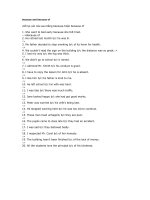Negotiations chap002 strategy and tactics of distributive bargaining
Bạn đang xem bản rút gọn của tài liệu. Xem và tải ngay bản đầy đủ của tài liệu tại đây (226.57 KB, 24 trang )
CHAPTER TWO
Strategy and Tactics of
Distributive Bargaining
McGraw-Hill/Irwin
Copyright © 2011 by The McGraw-Hill Companies, Inc. All rights reserved.
2-2
Three Reasons Negotiators Should
Be Familiar with Distributive
Bargaining
1. Independent situations require knowing how
this works in order to do well
2. Need to know how to counter the effects of
the strategies
3. Every situation has the potential to require
skills at the “claiming-value” stage
2-3
The Distributive Bargaining
Situation
• Goals of one party are in fundamental,direct
conflict to another party
• Resources are fixed and limited
• Maximizing one’s own share of resources is
the goal for both parties
2-4
The Distributive Bargaining
Situation
Situation includes:
• Starting points (initial offers)
• Target points
• Resistance points (walkaway)
• Alternative outcomes
2-5
The Distributive Bargaining
Situation
Party A - Seller
Walkaway Point
Initial Offer
Party B - Buyer
Target Point
Target Point
Asking Price
Walkaway Point
2-6
The Role of Alternatives to a
Negotiated Agreement
• Alternatives give the negotiator power to walk
away from the negotiation
– If alternatives are attractive, negotiators can:
• Set their goals higher
• Make fewer concessions
– If there are no attractive alternatives:
• Negotiators have much less bargaining power
2-7
The Distributive Bargaining
Situation
Party A - Seller
Walkaway Point
Target Point
Alternative
Initial Offer
Party B - Buyer
Asking Price
Alternative
Target Point
Walkaway Point
2-8
Fundamental Strategies
• Push for settlement near opponent’s resistance
point
• Get the other party to change their resistance
point
• If settlement range is negative, either:
– Get the other side to change their resistance point
– Modify your own resistance point
• Convince the other party that the settlement is
the best possible
2-9
Keys to the Strategies
The keys to implementing any of the four
strategies are:
• Discovering the other party’s resistance
point
• Influencing the other party’s resistance
point
2-10
Tactical Tasks of Negotiators
• Assess outcome values and the costs of
termination for the other party
• Manage the other party’s impressions
• Modify the other party’s perceptions
• Manipulate the actual costs of delay or
termination
2-11
Assess the Other Party’s Target,
Resistance Point, and Costs of
Terminating Negotiations
• Indirectly
– Determine information opponent used to set:
• Target
• Resistance points
• Directly
– Opponent reveals the information
2-12
Manage the Other Party’s
Impressions
• Screen your behavior:
– Say and do as little as possible
• Direct action to alter impressions
– Present facts that enhance one’s position
2-13
Modify the Other Party’s
Perceptions
• Make outcomes appear less attractive
• Make the cost of obtaining goals appear higher
• Make demands and positions appear more or
less attractive to the other party – whichever
suits your needs
2-14
Manipulate the Actual Costs of
Delay or Termination
• Plan disruptive action
– Raise the costs of delay to the other party
• Form an alliance with outsiders
– Involve (or threaten to involve) other parties
who can influence the outcome in your favor
• Schedule manipulations
– One party is usually more vulnerable to
delaying than the other
2-15
Positions Taken
During Negotiations
• Opening offers
– Where will you start?
• Opening stance
– What is your attitude?
• Competitive? Moderate?
• Initial concessions
– Should any be made? If so, how large?
2-16
Positions Taken
During Negotiations
• The role of concessions
– Without them, there is either capitulation or
deadlock
• Patterns of concession making
– The pattern contains valuable information
• Final offers (making a commitment)
– “This is all I can do”
2-17
Commitments:
Tactical Considerations
• Establishing a commitment
– Three properties:
• Finality
• Specificity
• Consequences
• Preventing the other party from committing
prematurely
– Their commitment reduces your flexibility
2-18
Ways to Create a Commitment
•
•
•
•
Public pronouncement
Linking with an outside base
Increase the prominence of demands
Reinforce the threat or promise
2-19
Commitments:
Tactical Considerations
• Ways to abandon a committed position
–
–
–
–
Plan a way out
Let it die silently
Restate the commitment in more general terms
Minimize the damage to the relationship if the
other backs off
2-20
Closing the Deal
•
•
•
•
•
Provide alternatives (2 or 3 packages)
Assume the close
Split the difference
Exploding offers
Deal sweeteners
2-21
Dealing with Typical
Hardball Tactics
• Four main options:
– Ignore them
– Discuss them
– Respond in kind
– Co-opt the other party (befriend them)
2-22
Typical Hardball Tactics
• Good Cop/Bad Cop
• Lowball/Highball
• Bogey (playing up an issue of little
importance)
• The Nibble (asking for a number of small
concessions to)
2-23
Typical Hardball Tactics
•
•
•
•
Chicken
Intimidation
Aggressive Behavior
Snow Job (overwhelm the other party
with information)
2-24
Summary
Negotiators need to:
• Set a clear target and resistance points
• Understand and work to improve their
BATNA
• Start with good opening offer
• Make appropriate concessions
• Manage the commitment process









